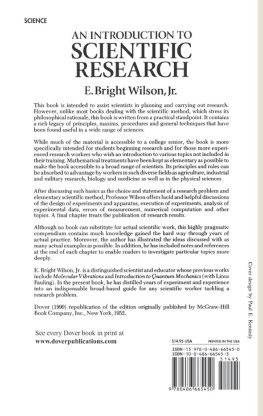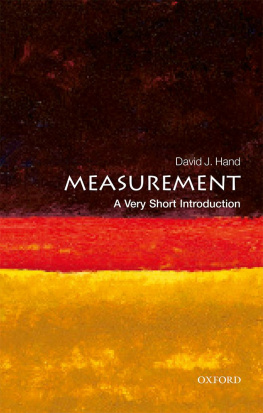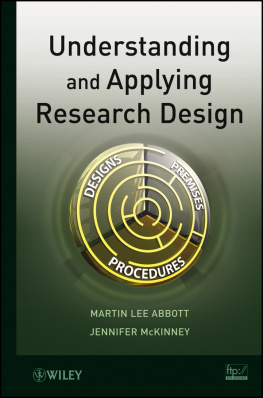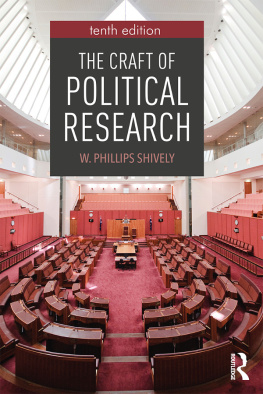AN INTRODUCTION TO SCIENTIFIC RESEARCH
AN INTRODUCTION TO SCIENTIFIC RESEARCH
E. BRIGHT WILSON, JR.
Theodore William Richards Professor of Chemistry, Emeritus, Harvard University
DOVER PUBLICATIONS, INC.
New York
Copyright 1952, 1980, 1990 by E. Bright Wilson, Jr.
All rights reserved under Pan American and International Copyright Conventions.
This Dover edition, first published in 1990, is an unabridged republication, with minor revision and a new preface, of the work originally published in 1952 by the McGraw-Hill Book Company, Inc., New York.
Library of Congress Cataloging-in-Publication Data
Willson, E. Bright (Edgar Bright), 1908
An introduction to scientific research/E. Bright Wilson, Jr.
p. cm.
Includes bibliographical references and index
ISBN 0-486-66545-3
1. Research. I. Title.
Q180.A1W57 1990
Manufactured in the United States by Courier Corporation
PREFACE TO THE DOVER EDITION
Most of the topics discussed in this book are sufficiently fundamental that they have changed very little as a result of the passage of time. There are, however, two areas where this statement is not even approximately true. These are electronics and the development of faster and faster digital computers. Progress has been so rapid in these fields that we have to face the fact that obsolescence has overtaken much of what was originally written for . Library use and the building of data banks are being revolutionized by the availability of more and more powerful computers and their use for the storage and retrieval of information. Slide rules, for another example, are now only good for museums. The successive development of mechanical calculators, then vacuum tube-based types, followed by transistors and integrated circuits, has totally altered the ways in which numbers can be stored and manipulated. Pencil and paper simply cannot compete with silicon chips carrying the equivalent of more than a million transistors.
E. BRIGHT WILSON, JR.
CAMBRIDGE, MASS.
PREFACE TO THE FIRST EDITION
Few readers of this preface will need to be convinced of the enormous, importance of scientific research in our present-day civilization or of the magnitude of the effort which is being expended in this activity. Anyone who has tried to do research also knows that it is in general a highly inefficient endeavor. An exploration into the unknown cannot be planned in advance with the precision of a mass-production process. Nevertheless, some investigators are far more effective than others and make fewer wrong decisions at the innumerable crossroads which are reached daily during the course of a typical research problem. We have no way of acquiring the inborn wisdom which is mostly responsible for their success, but perhaps there are a few techniques which we can learn from them.
This book is an attempt to collect in one place and to explain as simply as possible a number of general principles, techniques, and guides for procedure which successful investigators in various fields of science have found helpful. The emphasis is entirely on the practical rather than the philosophical or psychological aspects. Topics have been included only if they appeared to be useful to working scientists in more than one field. As a consequence the coverage is necessarily broad rather than deep.
Naturally a physical chemist cannot claim to be able to write a book equally useful in all the sciences. Nevertheless, many of the topics treated have been found useful by others in such diverse fields as agriculture, industrial and military research, biology, and medicine as well as in the physical sciences.
Much of the material should be understandable to a college senior, but the book is more specifically intended for students beginning research and for those more experienced research workers who wish an introduction to various topics which were not included in their training. The mathematical treatments have been kept as elementary as possible but are given where they seemed required.
In carrying out these objectives, I have acted simply as a collector of ideas from many areas, in most of which I claim no expertness. I have tried to present these ideas from the viewpoint of a practicing scientist and to illustrate them with as many actual examples as possible. Many of these are examples of the dire consequences of ignoring the maxims herein set down. In this field I do claim a certain authority; many of the blunders were original contributions of my own. I hope the reader will excuse an occasional statement which may strike him as too pontifical; it is only the fervor of the recent convert who has learned some things the hard way.
Naturally such a book as this could not have been written without a great deal of help from others, in the form of suggestions, criticism, and just plain instruction. I cannot begin to acknowledge here the aid of all those who have helped. There were, however, many who spent hours educating me in various areas and correcting my mistakes. These include D. J. Finney, P. A. P. Moran, M. G. Kendall, J. W. Tukey, and F. Mosteller. Most of the book was written while I was a Guggenheim Fellow and Fulbright grantee at Oxford, and I should like to acknowledge the indispensable assistance I received from the Guggenheim Foundation and the U.S. State Department. Moreover I am indebted to the chemists at Oxford for their very notable hospitality, particularly to Dr. and Mrs. J. W. Linnett.
Individual chapters have been read and criticized by some of the above and by Prof. G. B. Kistiakowsky, Dr. R. H. Hughes, Dr. R. M. Fristrom, and Dr. D. Eggers. The help of these and a number of other individuals is gratefully acknowledged, but of course they are in no way responsible for any errors of fact or judgment which the book may contain.
I am indebted to Prof. Ronald A. Fisher, Cambridge, to Dr. Frank Yates, Rothamsted, and to Messrs. Oliver & Boyd, Ltd., Edinburgh and London, for permission to reprint from their book Statistical Tables for Biological, Agricultural, and Medical Research. I also wish to thank the other authors and publishers who have granted permission for the use of various material.
Finally I should like to acknowledge the considerable importance of the suggestions, criticism, and sympathy received from my wife, Emily Buckingham Wilson.
E. BRIGHT WILSON, JR.
CAMBRIDGE, MASS.
INTRODUCTION
This book is intended to assist scientists in planning and carrying out research. In a sense, therefore, it deals with scientific method, but not from the usual philosophical viewpoint. Rather, the aim has been the practical one of gathering together a number of principles, maxims, procedures, and general techniques which have been found useful in a range of sciences. The principle of selection has been to include only topics which would help someone decide what to do next and which are of a broad nature not too specific to a particular science.
Scientific work, by its very nature, cannot be reduced to a routine process, but this makes it certain that there is much room for improvement in efficiency. Furthermore, skilled and experienced workers usually learn many procedures only after years of actual practice. No book can completely replace experience, but much knowledge gained this hard way can be transferred to others via the printed page.
The topics have been arranged more or less in the order in which they arise during the course of an investigation, starting with the choice of a problem and ending with the publication of the results. The different chapters and, to a considerable extent, the different sections of each chapter have been made as nearly independent of one another as seemed feasible so that the reader is encouraged to pick and choose the items he most needs. Where necessary, cross references have been provided. Some readers may find sections which are too difficult or too detailed for their immediate needs. The relative independence of the sections should permit skipping to later topics.
Next page







